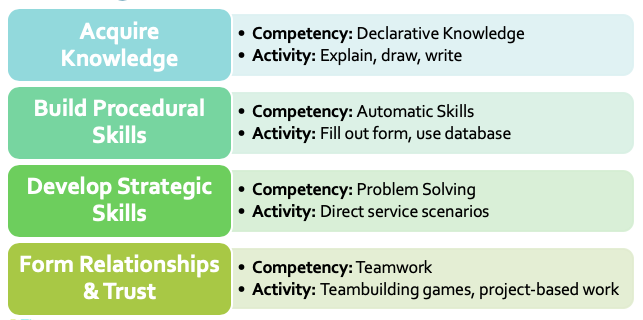
How to Craft Your Volunteer Training in 5 Easy Steps
If you haven’t received training as an instructional designer, you may wonder how to best estimate the cost and decide on the content you should include in your volunteer training (or training for staff who supervise volunteers).
Developing new training – or renovating old workshops that don’t serve you anymore – is an intensive process. It takes countless hours to pinpoint what subject you want to train and develop all of the materials needed.
Even if you decide to design your training curriculum in house, rather than hire and external consultant, it takes hours to develop modules that will actually get the job done.
And, what job is that, you might ask – the job of changing or at least adjusting human behavior. It’s a tall order that takes strategy, solid, planning, and skill.
In this guide we’ll walk you through the key steps and decisions that will set you up for success and ensure your investment of time and resources isn’t wasted.
Whether you plan to develop training for volunteers or leaders of volunteers, this guide will help.
Step One: Assess Whether Training is the Answer
Although training is often the first choice for addressing current or potential performance problems or barriers to success, it is not always the appropriate intervention or strategy. In fact, there are instances where training will not make any impact at all in a desired result.
Training is not a panacea. So, it makes sense to clearly assess whether training is really the answer to a management problem.
To ensure you are actually solving the real problem, and not wasting your time, take time to define which of your volunteers’ learning or performance gaps you are attempting to address before you come up with any solutions.
When it comes to volunteers or paid staff, there are several gaps you may need to address. They include:
- Knowledge Gaps – Not having enough of the right information to make decisions
- Skills Gaps – Not being able to do something (or do it well enough)
- Motivation or Attitude Gaps – When knowledge and skills may be present, but the learner still isn’t successful due to their own motivation
- Environment Gaps – When there is something blocking performance – (e.g., sufficient time, support, tools, etc.)
- Communication Gaps – Instructions aren’t clear or are contradictory
Knowledge and skills gaps can easily be addressed by training. However, motivation issues, flaws in the work environment, or communication breakdowns can rarely be solved with a workshop.
For example, common learning gaps for brand new volunteers include:
- How to explain the organization’s mission and services succinctly and accurately to the public
- How to fill out and submit the required paperwork completely and on time
- How to conduct work safely and what to do in the event of an emergency
- How we do things around here
However, motivating a volunteer to follow through on their commitments would likely not be solved by a workshop, unless it was infused with teambuilding and inspiration.
Furthermore, if the volunteer or employee is not the right fit in the first place, no amount of training will overcome that fact.
So, when you decide that training might be the answer, pause to determine which specific deficiencies you are trying to address. If you don’t, all of your hard work may be in vain.
Step Two: Pinpoint the Goals for Your Volunteer Training
Learning objectives are the critical foundation of any training course or workshop. They help you focus your course content on “need to know” information and leave behind unnecessary content that doesn’t help you (or your learner) meet clear, focused goals.
Learning objectives should be action-based, meaning 1) they are a reasonable task that the volunteer is expected to perform on a regular basis, and 2) they can be observed.
A learning objective is not helpful if it does not represent a behavior-based skill.
A simple way to pinpoint your learning objectives is to brainstorm answers to the following three questions.
At the end of the training …
- What will your learners be able to do?
- What learning (knowledge or skill) gap(s) will be filled?
- What behavior change will be brought about?
To further flush out your goals, consider the following four levels of competency you need to develop in your volunteer or employee training programs. Each competency below also includes examples of training activities that support each competency:
Volunteer Training Goals and Competencies

Once you have your preliminary list, begin to refine it down to a final list. The total number of training goals you identify depends on the length and complexity of the material to be taught.
As a general rule, you should aim for no more than three learning objectives for every one hour of instruction.
Step Three: Identify Your Key Project Constraints
Good instructional design is as much about what you include as it is about what you leave out. It is also an exercise in compromise.
There are never enough resources or enough time to train on everything. So, you have to make choices.
When it comes to volunteer training development, there are four main constraints you must manage:
- Limits on Training Development Time
- Limits on Learner Capability and Availability
- Limits on Available Technology & Software
- Limits on Budget (including the equivalent value of staff time)
While instructional development time varies according to the number of learning goals and the level of mixed media that needs to be developed, there is no doubt it will take longer if done in house.
Agency employees often have a raft of other competing duties and responsibilities, which impact how much focused time they can devote to this kind of extensive project. This will, in turn, affect how quickly you can have your program up and running.
The current hard realities in these areas will most often impact the content and scope of your training, as well as how it will be delivered.
This analysis, and your steps moving forward, often require consideration of challenging trade-offs and creative solutions. But, if you make the hard decisions now, you’ll be better suited to move forward in a focused and efficient way.
If your project is expansive or complex, at this point hiring a consultant with solid expertise in learning design and development can help you identify a full range of creative options that might be available.
They can also help you develop a realistic scope of work that also works within your project budget.
Step Four: Select Training Delivery Methods
Once you have made some of the harder decisions around your volunteer training, you can move on to the fun stuff.
Will your training be presented online or on land? Or, will it comprise a mix of both? With today’s advanced, yet affordable learning platforms, there are numerous practical reasons to take your training online.
Online training can help you …
- Reduce travel costs and reimbursements
- Realize economies of scale
- Eliminate long volunteer wait times
- Reduce time away from home or out of office
- Engage and support volunteers from anywhere in the world
- Increase speed and flexibility of instructional design
- Improve the consistency of training content and delivery
- Provide “just in time” information and skill building
- Minimize duplication of effort
- Reduce your agency’s carbon footprint
Volunteer Training Delivery Methods

It will take careful consideration to decide which methods and materials you need. A professional instructional designer can help you decide by providing insights. They can advise you on the ups and downs of each method and whether it might be appropriate for the experience levels of your learners, your organizational context, and your goals.
Some things to consider include …
- Ultimate Goals for Training – What is the expected depth of competency required
- Skills or Knowledge – Is the goal to actually gain the ability to do something or simply have general knowledge about it?
- Level of Preferred Interaction – Are you aiming for limited presentation or genuine interactivity?
- Trainer Experience Level – What experience does the presenter have with technology, presentation, facilitation, etc.? Is this sufficient to deliver a quality experience for learners?
- Budget and Project Timeline – Do you need the training right away, or can you wait for more extensive design to be completed? And, what budget do you have that can be put toward design and ongoing technology costs?
- Tech Capacity of Organization – What tools do you have on hand, and do you have the type of equipment and the level of internet connection required to train online?
- Tech Available to Learners – Do learners have access to reliable internet and devices needed, or can you assist in some way?
- Learner Tech Comfort – How experienced are your learners with the technology, and is the platform easy enough to learn and use?
Step Five: Decide Who Will Do the Work
At this point in the process, it’s a good time to decide whether you can afford to extend the expected development time or, alternately, whether you can find the budget to hire a dedicated professional to complete your project rapidly.
You have three major options when it comes to training design – do it yourself (or have another staffer do it), recruit a pro-bono volunteer, or hire an outside consultant.
There are pros and cons to each choice.
Do It Yourself
If you decide to take on the project yourself, expect the development time to take longer than it would when working with a consultant. Also, if you don’t have extensive design experience, expect that you may need to pilot test and make updates to your work as it may miss the mark initially.
Also, be sure you have developed an evaluation tool (like the Training Feedback Form found at the bottom of this page) that will assess whether or not your training is working.
Simply putting together a set of presentation slides that detail your topic is not effective instructional design. So, be sure to invest your time wisely, or risk poor results.
Recruit Pro-bono Volunteer
If you decide to go with a pro-bono or skilled volunteer, it’s a good idea to set up an agreement. So, it’s vital that you’ve already completed the first five sets detailed above. Volunteers will have little time to do those steps for you.
But, if you approach the project in a professional way, and you have an agreement in place, you’ll head off any misunderstandings before they crop up, and it’s more likely your project will be successful.
Hire a Consultant
Finally, if you decide to hire an outside consultant, make sure they have expertise in both volunteer management and training design. This will save you from having to explain common terminology or the differences between volunteers and employees.
In addition, most experienced consultants have a developmental framework they regularly use that has been refined over the years and results in a more efficient design process.
Finally, a Note About Intellectual Property
If you plan to engage others in creative work, you must be aware of, and respect, the copyright laws in your area. They play out differently around the world.
In today’s digital world, Intellectual Property (or IP) is critical to protect, and it helps keep creative companies in business. If all of their materials were shared without respect for intellectual property, businesses would no longer generate the revenue needed to keep going and organizations wouldn’t have experts to rely on.
Although most of the public doesn’t realize it, sharing or using content is the same as stealing a physical product. It affects the maker the same way through a dilution of their brand authority, damage to their reputation through lack of acknowledgement, and/or a loss in revenue.
Digital Shoplifting
In fact, we’ve coined the phrase “digital shoplifting” to refer to unauthorized sharing of our content. As creators, we work many hours to research and create content that matters. Folks need to respect that.
If you engage an outside consultant or pro-bono volunteer, make sure you are clear on who owns the final product. And, make sure this is detailed in a signed work agreement before the project starts.
And, be sure you ask if you aren’t clear on what the agreement says. I have worked with many clients who don’t fully understand how and when they can share materials I’ve developed for their projects, which leads to a lot of unnecessary back and forth once the materials are ready for use.
The Two Types of Intellectual Property Agreements
1) The consultant retains copyright and ownership of the intellectual property and grants you a royalty-free license to use the work in the ways describes in your scope of work. The client is prohibited from selling it to others and can only distribute the materials in the matter, and to the audience, describe in the agreement.
In general, this is a more affordable option because the maker retains the ability to generate revenue from the creative projects. I often use this with clients with whom I have a speaking or training contract.
2) The consultant divests intellectual property ownership to you, the client. In this case, you are creating a work for hire agreement and maintain the right to own the work the maker created for you. In many cases, this may also restrict you from selling the work, or sharing the maker’s ideas, with others. It may also offer the maker the opportunity to include this work in their marketing portfolio.
In general, this is a more expensive option because the maker loses some of their ability to generate future revenue from the same (or a similar) product and must dedicate more time and energy developing something new. I use this when I am building bespoke programs and tools for my consulting clients.
While these are the two main options, there are other iterations – for example, both the maker and the client may decide to share revenue gained from training that is, in turn, marketed to a community of learners. So, don’t hesitate to bring these up with potential consultants and see what might be mutually beneficial.
As with any legalese, make sure your attorney reviews any agreement you enter into, both with paid or pro-bono creative talent.
As a final word, don’t let this guide to volunteer training development deter you from moving forward. If you make the tough decisions outlines in this guide before you start developing your materials, you’ll save enormous amounts of wasted time and energy in req-rites, stalled projects, and overall frustration.








Leave A Comment